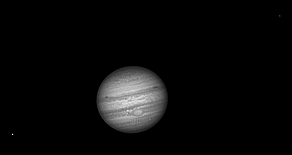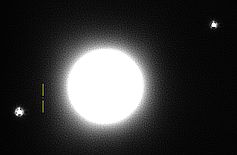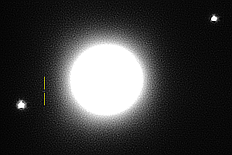Catching Jupiter inner and outer mini moons
Jupiter has a lot of small moons. Some are very close to the planet, other are on quite big orbits. They are very faint but amateurs may catch then on photographs without sophisticated equipment... lets start from the inner moons.

Four moons orbit Jupiter on very tight orbits - they are closer to Jupiter than Io. Metis, Adrastea, Amalthea and Thebe are those very small and faint moons. To catch them on photographs they must be as far from the planet as possible. Stellarium 0.11 got ephemeris for those moons and it seems to point their location accurately - so use this app to check when given moon will be available for imaging.
The problem with imaging fainter than 10 mag moons is the very big and bright Jupiter - it will usually over-glow those moons. By some processing and imaging tricks we can however catch those moons with planetary or DS cameras. Amalthea is the easiest as it moves far from Jupiter and is reasonably bright.
For filters you may try infrared or broader longpass filters (to limit seeing effect and to limit planet brightness vs moon brightness). There are also papers about using 889 nm methane band filter for all 4 of the moons but that needs rather long (and guided) exposures with cooled DS cameras.
Focal length shouldn't be big, just to have some pixels between Jupiter and Io orbit. I use C11 at f/10 (and used C8 at f/10). For imaging planetary cameras can be used, but also DS cams can work nicely or better. When you start - collect few AVIs, best would be with few filters and different capture settings.
Set the exposure time so that the planet is only slightly overexposed. For planetary cams start at full gain, then shoot the avi at bit lower gain and increased exposure time. For DS cams - use the standard gain value (if it can be changed). If you lower the gain to much in a planetary cam - you will loose the moon signal. If you got that - collect some AVIs or FITS frames and stack them, for example in Registax 5.
Processing isn't complicated, but it's tricky. Start with sharpening the final stack, but not to aggressively. Jupiter should be nice white ball. Then increase levels up and look if very small and faint dots will show up in the moon orbital plane. Limiting the background noise by levels also kills the moon signal. It's also a good thing to have multiple images to exclude any artefacts or hot pixels.
f/10; Yellow #12 longpass filter 13.10.2011 20:47/53/54 - Amalthea visible (14,81 mag):


"External" moons are also quite exotic, and there is a lot of them to catch:

Comment article